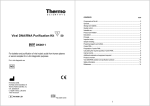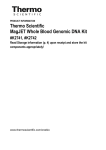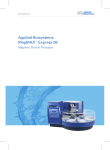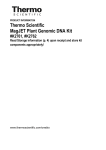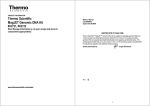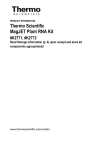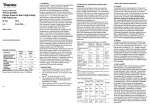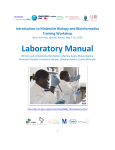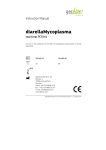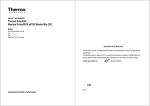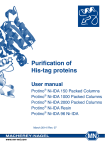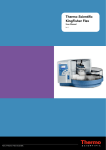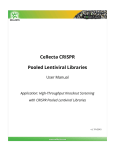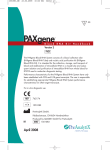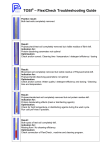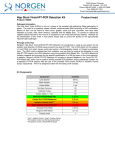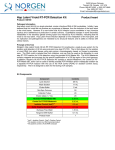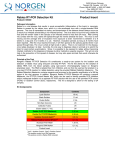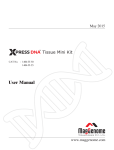Download GeneJET™ Genomic DNA Purification Kit
Transcript
PRODUCT INFORMATION Thermo Scientific GeneJET Viral DNA and RNA Purification Kit #K0821 www.thermoscientific.com/onebio #__ Packaging Lot __ Exp. __ CERTIFICATE OF ANALYSIS Quality of the kit was tested by purification of RNA and DNA from 200 µl of spiked human plasma. Yield of nucleic acids was evaluated by RT-qPCR and qPCR, and compared with spiked copy number. Quality authorized by: Rev.2. . c Jurgita Žilinskiene CONTENTS page COMPONENTS OF THE KIT ............................................................................................... 2 STORAGE ........................................................................................................................... 2 DESCRIPTION..................................................................................................................... 2 PRINCIPLE .......................................................................................................................... 3 IMPORTANT NOTES ........................................................................................................... 3 SAMPLE HANDLING ........................................................................................................... 4 PREPARING REAGENTS AND BUFFERS ......................................................................... 5 CARRIER RNA .................................................................................................................... 5 PREPARATION OF CARRIER RNA .................................................................................... 5 CALCULATING THE REQUIRED QUANTITY OF CARRIER RNA ...................................... 6 INTERNAL CONTROL ......................................................................................................... 6 ADDITIONAL MATERIALS AND EQUIPMENT REQUIRED ................................................ 6 PROTOCOLS....................................................................................................................... 7 TROUBLESHOOTING ........................................................................................................11 SAFETY INFORMATION ....................................................................................................12 REFERENCES....................................................................................................................13 1 COMPONENTS OF THE KIT GeneJET Viral DNA and RNA Purification Kit Column Preparation Liquid (red cap) Lysis Solution* Wash Buffer 1 (concentrated)* Wash Buffer 2 (concentrated) Eluent (white cap) Proteinase K (green cap) Carrier RNA, dried (blue cap) Spin Columns preassembled with Wash Tubes Wash Tubes (2 ml) Handbook #K0821 50 preps 2 x 1.4 ml 12 ml 25 ml 11 ml 3 x 1.25 ml 2 x 1.3 ml 1 vial 50 4 x 50 1 * contains guanidine hydrochloride (guanidinium chloride). STORAGE When the kit is delivered, remove the Carrier RNA from the package and store in the original aluminum bag at −20°C. Other components of the kit should be stored at room temperature (15-25°C). All components are stable until the listed expiration date. Wash Buffer 1 and Wash Buffer 2 are stable until the listed expiration date after addition of ethanol. DESCRIPTION The Thermo Scientific GeneJET Viral DNA and RNA Purification Kit is designed for rapid and efficient purification of high quality viral nucleic acids from various human and animal liquid samples such as plasma, serum, whole blood, saliva, nasal and buccal swabs, urine (cells should be collected before purification), urogenital swabs and milk. The kit utilizes a silica-based membrane technology in the form of a convenient spin column. Nucleic acids from lysed samples bind to the column membrane while impurities are effectively removed during subsequent washing and centrifugation steps. Finally, readyto-use nucleic acids are eluted from the column. The purified viral nucleic acids are free of proteins, nucleases, and other contaminants or inhibitors of downstream applications. Isolated DNA and RNA can be directly used in PCR, qPCR or other nucleic acid based assays. Host genomic DNA or RNA co-purified from liquid cell-containing samples typically does not interfere with viral nucleic acid yields due to high capacity of the spin column membrane (up to 50 µg). To minimize irregularities in results, the product must be used with an appropriate internal control as well as positive and negative controls throughout the process of sample preparation, amplification and detection. 2 PRINCIPLE The GeneJET™ Viral DNA and RNA Purification Kit uses well-established nucleic acid isolation and purification technique comprised of following steps: 1 Sample lysis The sample is lysed by incubation with Lysis Solution and Proteinase K under denaturating conditions at elevated temperatures (56°C). The Lysis Solution and Proteinase K inactivate both RNases and DNases, ensuring protection of viral nucleic acids against degradation. 2 Binding viral nucleic acids to the spin column membrane The lysed sample is transferred to a spin column where released viral nucleic acids immediately bind to the silica-based filter in the presence of chaotropic salts. The remaining lysate is removed by centrifugation. 3 Removing remaining contaminants The remaining contaminants are removed during three wash steps using Wash Buffer 1 and Wash Buffer 2, whereas pure nucleic acids remain bound to the membrane. 4 Elution of pure viral nucleic acids Pure viral nucleic acids are released from the spin column filter using Eluent. The purified nucleic acids are ready for subsequent use in downstream applications. IMPORTANT NOTES • Ensure the integrity of the kit components upon the delivery. Contact technical service or your local distributor in case of damage. Do not use damaged kit components. • The Lysis Solution and Wash Buffer 1 contain irritants. Always wear gloves and follow standard safety precautions when handling these reagents. For more information refer to SAFETY INFORMATION (page 12) and Material Safety Data Sheets. • All sample material and waste should be regarded as potentially infectious. Wear the proper protection when handling samples and waste. Avoid any skin or eye contact! Work under laminar air flow conditions if possible until samples are lysed. Disinfect all work surfaces thoroughly after the procedure. Follow proper waste disposal guidelines as recommended by local authorities. • The following steps should be taken in order to avoid cross-contamination: always change pipette tips between liquid transfers (aerosol-barrier pipette tips recommended); open only one tube at a time; use disposable gloves and discard if contaminated. • Always use RNase-free equipment. • Use only a freshly prepared mixture of Carrier RNA and Lysis Solution when beginning a new extraction procedure! • Before beginning the procedure, a new Spin Column must be prepared by adding 50 μl of Column Preparation Liquid into the center of the column membrane. Do not centrifuge the column after addition of Column Preparation Liquid. 3 SAMPLE HANDLING • If possible, use only fresh sample material. • Plasma, serum, whole blood samples can be stored at 2-8°C for up to 24 hours, or at −20°C or −70°C for long term storage. • Urogenital swabs can be stored at 2-8°C for up to 48 hours. For longer term storage cells should be collected by centrifugation and stored at −20°C or −70°C • Nasal and buccal swabs can be stored at 2-8°C for up to 48 hours. • Urine samples should be stored at 2-8°C for up to 12 hours (with 0.5 M EDTA added to 50 mM final concentration), or at −20°C or −70°C for long term storage (cells should be collected by centrifugation). For viral RNA purification, it is recommended to collect cells by centrifugation immediately after sample collection. • Do not freeze/thaw samples more than once. • Equilibrate samples to room temperature (20±5°C) before use. Remove precipitates from plasma/serum samples, if any, by centrifugation for 5 min at 3,000 x g. • Use EDTA or citrate treated plasma samples. 4 PREPARING REAGENTS AND BUFFERS Add the indicated volume of ethanol (96-100%) to the concentrated Wash Buffer 1 and concentrated Wash Buffer 2 prior to first use: #K0821, for 50 preps Wash Buffer 1 Wash Buffer 2 Concentrated wash buffer 25 ml 11 ml Ethanol (96-100%) 15 ml 44 ml Total volume 40 ml 55 ml • Ensure all working solutions are prepared according to the recommendations in the protocol. • After preparing each solution, mark the bottle to indicate that this step has been completed. • Check all solutions in the kit for any salt precipitation before each use. Re-dissolve any precipitate by warming the solution to 37°C, and then equilibrate to room temperature (20±5°C). • For swabs or collected cells, reconstitute cells to recommended sample volume using PBS (137 mM NaCl, 2.7 mM KCl, 10 mM Na2HPO4, 2 mM KH2PO4, pH 7.4) • It is the user’s responsibility to use appropriate controls during the procedure. CARRIER RNA Usage of Carrier RNA is important for efficient recovery of viral nucleic acids for two reasons. First, Carrier RNA facilitates binding of viral nucleic acids to the silica membrane, especially when there are only a small number of viral nucleic acid molecules in the sample. Additionally, in the rare event when there are a small number of active RNase molecules, large amounts of Carrier RNA reduce the probability of viral RNA being degraded under chaotropic conditions. If Carrier RNA is not added to the Lysis Solution, reduced viral nucleic acid yields may result. PREPARATION OF CARRIER RNA Carrier RNA is provided in a dried state packed in a moisture-impermeable aluminum bag. Prior to the first use, reconstitute the dried Carrier RNA by adding 300 µl of Eluent. Allow the freshly reconstituted Carrier RNA to incubate for 5 min at room temperature, then mix thoroughly and briefly centrifuge the vial. Use immediately or store at −20°C. Do not freezethaw the reconstituted Carrier RNA more than 10 times. If only few samples will be processed at a time, divide the Carrier RNA solution into 50 μl aliquots (using nuclease-free tubes) and store at −20°C or −70°C. 5 CALCULATING THE REQUIRED QUANTITY OF CARRIER RNA When starting a new procedure, always use a freshly prepared mixture of Carrier RNA and Lysis Solution. To calculate the correct quantity of Carrier RNA and Lysis Solution required to process multiple samples, use the following table. Supplement Lysis Solution with the required quantity of Carrier RNA and mix by pulse-vortexing or pipetting. No. samples Vol. Lysis Solution, ml Vol. Carrier RNA, µl No. samples Vol. Lysis Solution, ml Vol. Carrier RNA, µl 1 0.22 5.5 13 2.86 71.5 2 0.44 11.0 14 3.08 77.0 3 0.66 16.5 15 3.30 82.5 4 0.88 22.0 16 3.52 88.0 5 1.10 27.5 17 3.74 93.5 6 1.32 33.0 18 3.96 99.0 7 1.54 38.5 19 4.18 104.5 8 1.76 44.0 20 4.40 110.0 9 1.98 49.5 21 4.62 115.5 10 2.20 55.0 22 4.84 121.0 11 2.42 60.5 23 5.06 126.5 12 2.64 66.0 24 5.28 132.0 Note: Required volumes (µl) of Carrier RNA are calculated using following formula: N x 0.22 ml = Y ml Y ml x 25.0 µl/ml = Z µl Where: N – number of samples to be processed; Y – calculated volume (ml) of Lysis Solution ; Z – volume (µl) of Carrier RNA to add to Y ml of Lysis Solution . INTERNAL CONTROL The presence of an internal control throughout the extraction and purification procedure may be necessary for certain assays. Please refer to the user manual provided with the downstream detection assay for further directions on how to use an internal control. • • • • • • • • • • ADDITIONAL MATERIALS AND EQUIPMENT REQUIRED Pipettes and sterile, nuclease-free pipette tips with aerosol barrier Vortex Ethanol (96-100%) Microcentrifuge Thermomixer Disposable gloves Measuring cylinder Nuclease-free microcentrifuge tubes of an appropriate size for preparing mixtures of Carrier RNA and Lysis Solution Microcentrifuge tubes for sample lysis and elution. RNase-free tubes should be used for RNA elution. 6 PROTOCOLS Before starting • Read the user manual; make sure all the directions are followed as indicated. • Make sure all working solutions and samples have been prepared according to recommendations (page 5-6). • Ensure all necessary equipment and additional materials are available before beginning the procedure (page 6). • Organize proper handling of potentially infectious waste before beginning the procedure. • Follow recommended safety instructions, as you will be working with potentially infectious material. • Attention and care must be taken during the entire process. • All centrifugation steps must be performed at room temperature. A. Viral nucleic acid purification main protocol This protocol is for viral DNA and RNA purification from 200 µl of EDTA- or citrate- treated plasma, serum, blood or milk samples. For other sample types refer to additional protocols (page 9). Following procedure provides instruction for processing one sample. When using larger than 200 µl (up to 400 µl) sample volumes refer to protocol E (page 10). Step Procedure 1 Add 50 µl of Column Preparation Liquid to the center of Spin Column membrane, so that the membrane is entirely moistened. Note • Before starting the procedure, each new Spin Column must be prepared by treating it with Column Preparation Liquid. Column treatment maximizes binding of the nucleic acids to the membrane, resulting in more consistent yields. • Do not centrifuge the prepared column. The prepared column should be stored at room temperature until it is used for sample processing. 2 Load 200 µl of sample to an empty 1.5 ml lysis tube. Add 200 µl of Lysis Solution (supplemented with Carrier RNA), and 50 µl of Proteinase K, mix thoroughly by vortexing or pipetting. Incubate the sample for 15 min at 56°C in a thermomixer. Leave thermomixer turned on for Eluent preheating during later steps of the procedure. Centrifuge for 3-5 s at full speed to collect any sample solution from the inside of the lid. Note • Supplement Lysis Solution with Carrier RNA prior to use (page 6)! Use the appropriate internal control as required in a downstream assay user’s manual. Do not add the internal control directly to plasma samples. Do not add Proteinase K directly to Lysis Solution. 3 Add 300 µl of ethanol (96-100%) and mix by pipetting or vortexing. Incubate the sample at room temperature for 3 min. Centrifuge for 3-5 s at full speed to collect drops from the inside of the lid. 4 Transfer the lysate to the prepared Spin Column preassembled within the wash tube. Centrifuge the column for 1 min at 6,000 x g. Discard the Wash Tube containing flow-through. Place the Spin Column into a new 2 ml Wash Tube. 7 Note • Ensure that a new Spin Column has been prepared as described in step 1! 5 Add 700 µl of Wash Buffer 1 supplemented with ethanol to the Spin Column. Centrifuge the column for 1 min at 6,000 x g. Discard the Wash Tube containing flow-through. Place the Spin Column into a new 2 ml Wash Tube. Note • Supplement concentrated Wash Buffer 1 with ethanol prior to the first use (Page 5)! 6 Add 500 µl of Wash Buffer 2 supplemented with ethanol to the Spin Column. Centrifuge the column for 1 min at 6,000 x g. Discard the Wash Tube containing flow-through. Place the Spin Column into a new 2 ml Wash Tube. Note • Supplement concentrated Wash Buffer 2 with ethanol prior to the first use (Page 5)! 7 Add 500 µl of Wash Buffer 2 supplemented with ethanol to the Spin Column. Centrifuge the column for 1 min at 6,000 x g. Discard the Wash Tube containing flow-through. Place the Spin Column into a new 2 ml Wash Tube. 8 Centrifuge the column for 3 min at 16,000 x g. Discard the Wash Tube containing remaining flow-through. 9 Place the Spin Column into a new 1.5 ml elution tube. Add 50 µl of Eluent preheated to 56°C to the center of Spin Column membrane. Incubate for 2 min at room temperature. Centrifuge the column for 1 min at 13,000 x g. Discard the Spin Column. Note. • Lower volume of Eluent (30 -40 µl) can be used in order to concentrate eluted nucleic acids. Larger elution volumes (up to 100 µl) can also be used but may result in dilution of the viral nucleic acid sample. 10 Keep the elution tube containing pure viral nucleic acids. Use the purified nucleic acids immediately or store at −20 °C or -70 °C . Note • qPCR and RT-qPCR inhibition might occur, if lower than 50 µl volume of Eluent is used for elution. • For further use in downstream qPCR applications, use 1 - 10 µl of viral DNA per 25 µl reaction volume. For reverse transcription (RT), use 1 - 10 µl of viral RNA per 20µl cDNA synthesis reaction volume. 8 B. Nucleic acid purification from nasal and buccal swabs Step Procedure 1 To collect a sample, scrape the swab 5-6 times against the inside cheek or nose. 2 Swirl the swab for 2-3 min in 200 µl of 1 x PBS or TE buffer. 3 Go to step 1 of the standard Viral Nucleic Acid Purification Protocol (page 7). C. Nucleic acid purification from urine Step 1 2 3 4 5 Procedure Add 0.5 ml of 0.5 M EDTA to 4.5 ml of urine (final concentration 50 mM). Note: Urine samples may contain insoluble salt precipitates that can reduce nucleic acid yields, thus limiting sample volume used for purification. Centrifuge 10 min at 800 x g (~3,000 rpm). Discard the supernatant. Resuspend the pellet in 200 µl of 1x PBS. Go to step 1 of the standard Viral Nucleic Acid Purification Protocol (page 7). Note. Urine samples larger than 4.5 ml are not recommended. D. Nucleic acid purification from saliva Step 1 2 3 Procedure To collect cells, centrifuge the saliva sample for 5 min at 3,000 x g. Resuspend cells in 200 µl of 1 x PBS or TE buffer. Go to step 1 of the standard Viral Nucleic Acid Purification Protocol (page 7). 9 E. Viral nucleic acid purification protocol for larger sample volumes (up to 400 µl) Important: Lysis Solution and ethanol are the only components that have to be scaled up. Step 1 2 3 4 5 Procedure Add 50 µl of Column Preparation Liquid to the center of Spin Column membrane, so that the membrane is entirely moistened. Note • Before starting the procedure, each new Spin Column must be prepared by treating it with Column Preparation Liquid. Column treatment maximizes binding of the nucleic acids to the membrane, resulting in more consistent yields. • Do not centrifuge the prepared column. The prepared column should be stored at room temperature until it is used for sample processing. Load the sample to an empty 2.0 ml lysis tube. Add the same volume (1:1) of Lysis Solution (supplemented with Carrier RNA), and 50 µl of Proteinase K, mix thoroughly by vortexing or pipetting. Incubate the sample for 15 min at 56°C in a thermomixer. Leave thermomixer turned on for Eluent preheating during later steps of the procedure. Centrifuge for 3-5 s at full speed to collect any sample solution from the inside of the lid. Note • Supplement Lysis Solution with Carrier RNA prior to use (page 6)! Use the appropriate internal control as required in a downstream assay user’s manual. Do not add the internal control directly to plasma samples. Do not add Proteinase K directly to Lysis Solution. Add ethanol (96-100%). Use 150 µl ethanol for every 100 µl of initial sample volume. Mix by pipetting or vortexing. Incubate the sample at room temperature for 3 min. Centrifuge for 3-5 s at full speed to collect drops from the inside of the lid. Transfer the lysate to the prepared Spin Column preassembled within the wash tube. Do not load more than 700 µl of lysate on the column (For larger volumes, load the remaining volume of the lysate to the same column and centrifuge for a second time). Centrifuge the column for 1 min at 6,000 x g. Discard the flow-through. Place the Spin Column into a new 2 ml Wash Tube. Go to step 5 of the standard Viral Nucleic Acid Purification Protocol (page 7). 10 TROUBLESHOOTING Problem Low nucleic acid yield Column clogging Degraded RNA Possible cause and solution Improper spin column preparation. Make sure the Spin Column has been prepared properly by adding Column Preparation Liquid as described on page 5. Ethanol was not added to the lysate. Make sure that ethanol was added to the lysate before applying the sample to the purification column. Ethanol was not added to Wash Buffers 1 and 2. Make sure that ethanol was added to Wash Buffers 1 and 2 prior to the first use. Low percentage ethanol used. Use only 96-100% ethanol. Do not use denatured or 95% ethanol. Carrier RNA was not added to the lysate. Reconstitute carrier RNA in Eluent and mix with Lysis Solution as described on page 5. Degraded carrier RNA. Do not freeze-thaw the reconstituted Carrier RNA more than 10 times. Store at −20°C to −70°C. Viral nucleic acid eluate too dilute. Use recommended 30-50µl of Eluent. Improper elution conditions. Apply preheated Eluent into the center of Spin Column membrane as described on page 5. Starting material was not completely disrupted. Reduce the amount of starting material and increase disruption time. Precipitates were not removed. When using plasma samples, remove visible kryoprecipitates by centrifugation for 5 min at 3000 x g. RNase contamination. To avoid RNase contamination, wear gloves during all procedure and change gloves frequently. Use sterile, disposable RNase free pipette tips. Remove RNase contamination from non-disposable items and work surfaces. Poor quality of samples. Always use fresh samples or samples handled as recommended on page 4. For lysis, process the sample quickly to avoid degradation. 11 SAFETY INFORMATION Lysis Solution Xn Harmful Hazard-determining component of labeling: Guanidinium chloride Risk phrases R22 Harmful if swallowed. R38 Irritating to skin. R41 Risk of serious damage to eyes. R52/53 Harmful to aquatic organisms may cause long-term adverse effects in the aquatic environment. Safety phrases S23 Do not breathe gas/fumes/vapour/spray. S26 In case of contact with eyes, rinse immediately with plenty of water and seek medical advice. S36/37/39 Wear suitable protective clothing, gloves and eye/face protection. S60 This material and its container must be disposed of as hazardous waste. S61 Avoid release to the environment. Refer to special instructions/safety data sheets. Wash Buffer 1 Xn Harmful Hazard-determining component of labeling: Guanidinium chloride Risk phrases R22 Harmful if swallowed. R36/38 Irritating to eyes and skin. Safety phrases S23 Do not breathe gas/fumes/vapour/spray. S26 In case of contact with eyes, rinse immediately with plenty of water and seek medical advice. S36/37 Wear suitable protective clothing and gloves. S60 This material and its container must be disposed of as hazardous waste. 12 Proteinase K Xn Harmful Hazard-determining component of labeling: Proteinase, Tritirachium album serine Risk phrases R42 May cause sensitization by inhalation. Safety phrases S23 Do not breathe gas/fumes/vapor/spray. S36 Wear suitable protective clothing. S45 In case of accident or if you feel unwell, seek medical advice immediately (show the label where possible). S60 This material and its container must be disposed of as hazardous waste. REFERENCES 1. Boom, R., C.J.A. Sol, M.M.M. Salimans, C.L. Jansen, P.M.E.W. Dillen, and J. van der Noordaa. 1990. Rapid and simple method for purification of nucleic acids. J. Clin. Microbiol. 28:495–503. PRODUCT USE LIMITATION This product is developed, designed and sold exclusively for research purposes and in vitro use only. The product was not tested for use in diagnostics or for drug development, nor is it suitable for administration to humans or animals. Please refer to www.thermoscientific.com/onebio for Material Safety Data Sheet of the product. © 2012 Thermo Fisher Scientific Inc. All rights reserved. All trademarks are the property of Thermo Fisher Scientific Inc. and its subsidiaries. 13















